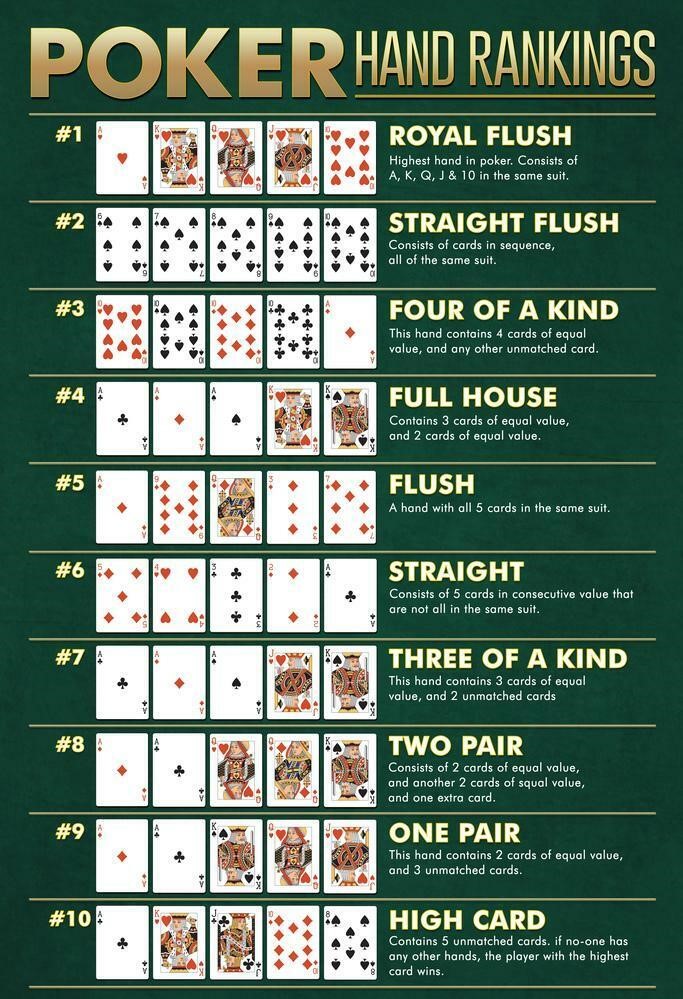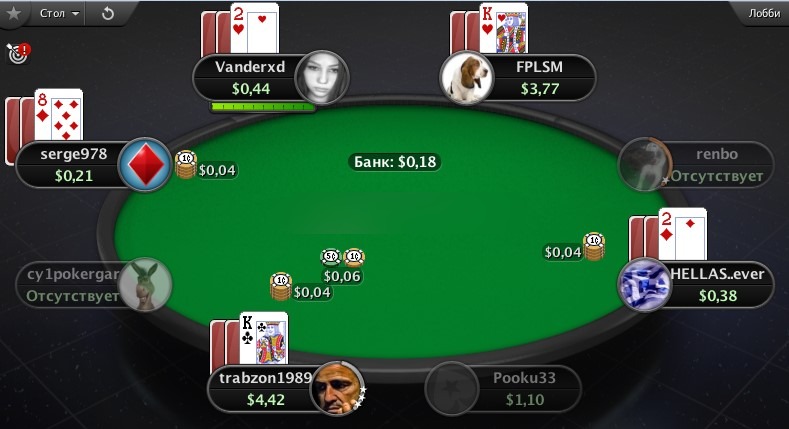7-card stud hi-lo
7-card stud hi-lo: Rules, Combinations, Strategies
Among the regulars of poker rooms, 7-card stud is popular, and it comes in several variations, including hi-lo. This variety is notable because it requires players to simultaneously form two combinations. Due to this feature, the gameplay becomes more complex but also more exciting and interesting.
Rules of the Game
The game of 7-card stud begins with each player making a mandatory bet called an ante. Its size is 10% of the big blind. For example, if you’re playing at a $0.5/1 limit table, each player needs to contribute 10 cents to the pot at the start.
After the pot is formed, the main game begins and unfolds in several stages:
- 3rd Street: All players at the table receive three cards each. Two of them are placed face down on the table, and one is dealt face-down. The player with the lowest face-up card starts the betting, making a bring-in bet, which is typically 2-2.5 times the ante or a larger amount. Then players take turns to make decisions regarding the further course of the game.
- 4th Street: Each player receives one more face-up card. Then the next round of betting begins. The player with the strongest exposed combination goes first.
- 5th and 6th Streets: These streets proceed similarly to the fourth – players are dealt one exposed card each, and betting takes place.
- 7th Street: This is the final stage where players receive one face-down card each and proceed to the last round of betting. After this, they compare their combinations.
Let’s focus separately on the actions available to players during the betting rounds. You can match your opponent’s bet – call, raise the bet – raise, or fold your cards – fold. From the fourth street onwards, you can also check, which means passing your turn.
Combinations in 7-card stud hi-lo
During the game, players need to form two combinations – high and low. The high hand follows the classic ranking of poker hands. It’s formed according to standard rules, where the highest card is the lowest combination, and a royal flush is the strongest.

Low refers to the lowest combination. It should not include ranks higher than eight, and aces count as ones. Flushes and straights are not considered in low hands.
In each hand, every player compares their low and high combinations with their opponents. The players with the best combinations in each category win the pot. This means that the money at stake is split between two players.
An important note: not all hands will allow players to form low combinations since they must adhere to the rules mentioned above. In such situations, there is no splitting of the pot. It goes to the player with the strongest high combination.
Game Strategy
When playing this variation of poker, the primary focus should be on forming a high hand. In this case, you can contend not only for half the pot but also the entire pot when opponents don’t reveal a low hand at showdown.
It’s not advisable to prioritize forming the lowest combination. Playing a low hand is always risky, and it’s challenging to assemble the best low hand. Often, disputes arise, and then the ranks of the cards are compared from the highest to the lowest. Sometimes, these ranks match another opponent’s, resulting in the player receiving not half the pot but only 25%.
Variations of the Game
7-card stud is available to play in its classic version, where players only need to form a high hand. As a result, only one player wins the pot in the final stage. The exception is hands where two or more opponents have identical combinations. In such cases, the pot is divided.

Another modification of the discipline is 5-card stud. In this version, players also need to form only the highest combination. However, it differs from the classic version in the number of streets, which are two less, and participants play with 5-pocket cards during the hand. This makes it more challenging to form the best combination.
Differences from Other Poker Variants
7-card stud hi-lo differs from Texas Hold’em and Omaha in the following ways:
- Number of pocket cards: In Hold’em, players are dealt two pocket cards, while in Omaha, they receive four. In 7-card stud hi-lo, players receive varying numbers of pocket cards throughout the hand.
- Absence of a board: In Hold’em and Omaha, five community cards are placed on the table, and all players can use them to form combinations. In 7-card stud hi-lo, there is no community board, and players rely solely on their pocket cards.
- Presence of blinds: In Hold’em and Omaha, only two players are required to make compulsory bets – the small blind and big blind. In 7-card stud hi-lo, players do not use blinds; instead, they use antes.
Where to Play Online
Finding applications for computer play in 7-card stud can be challenging, as most software supports only Texas Hold’em or Omaha. However, 7-card stud poker can be found in online poker rooms, including “Pokerdom.” These rooms offer both “play money” and “real money” modes, allowing you to play at regular tables or participate in tournaments with guaranteed prizes.
Additional advantages of playing in online poker rooms include:
- High-quality software for both mobile and desktop versions.
- Access to various types of poker.
- Bonuses for registration and deposits.
- Quality customer support.
- Diverse promotions and a VIP program.
- Convenient payment methods.
Limits and Other Features
When playing 7-card stud poker, it’s essential to consider the limits on bet sizes:
- On the 3rd and 4th streets, you cannot bet more than the size of the small blind.
- On the 5th to 7th streets, you can raise with increments of one big blind.
- In a single betting round, no more than four raises can be made.
Downloading 7-Card Stud Poker
Installing the application is an essential step to start playing poker, but before installing the software, you need to download it. To do this, use the link on the poker room’s official website.
Here are instructions for downloading and installing the application using “Pokerdom” as an example:
- Open the poker room’s official website.
- In the menu, select the “Poker” section.
- On the page with applications, click the “Download” button.
- Wait for the download to complete.
- Locate the installer in the Downloads folder and run it.
- Choose the language version of the software.
- Click the “Install” button.
How to Get Started for Beginners
In poker rooms, you cannot play without registering, so every new customer must create an account before sitting down at a table or participating in a tournament. This process takes no more than 2-3 minutes.
Here’s how to register using “Pokerdom” as an example:
- Go to the main page of the poker room’s official website.
- In the upper part of the interface, click the “Registration” button.
- Fill out the form with your email address.
- Choose the account currency (options typically include rubles, euros, dollars, tenge, sums).
- Specify your country of residence.
- Create a password of 8 characters or more.
- Agree to the room’s rules.
- Click the “Create Account” button.
The next step is to launch the client. Click on the poker room’s application icon on your desktop. After that, enter your email address and password in the form. After logging in, you will have access to the lobby, where you can explore available tournaments and cash games. However, to play for real money, you’ll need to make a deposit.
How to Deposit Funds:
- In the lobby, click the “Deposit” button.
- Choose a convenient payment method from the options provided.
- Specify the deposit amount.
- Click the “Deposit” button.
- Confirm the transfer of funds to your gaming account.
Deposits are credited to your account balance immediately, allowing you to start playing without delay.
Poker Education
Poker is a game of skill, and mastering it requires knowledge not only of the rules and hand rankings but also other important nuances. Therefore, it’s essential to undergo proper training.
For Beginners:
You can learn the basics of poker in any online poker school. For example, PokerHouse is an educational project by “Pokerdom” that offers several free courses for novice players. These courses are sufficient to understand the rules, grasp basic strategies, and learn fundamental tactical techniques.
For Professionals:
More experienced players may benefit from paid training programs available in online schools or opt for personal coaching sessions with a trainer. In any case, this will help improve your skill level, ultimately positively impacting your win rate.
For all poker players, regardless of experience and skill level, it’s recommended to read books, study educational materials on informational websites, and watch videos on demand (VODs). This will allow you to delve even deeper into the nuances of the game and extract a good profit from it in the long run.
